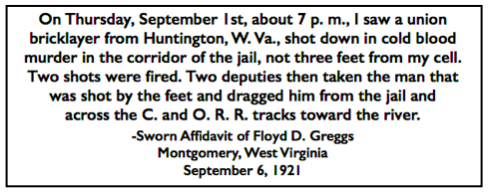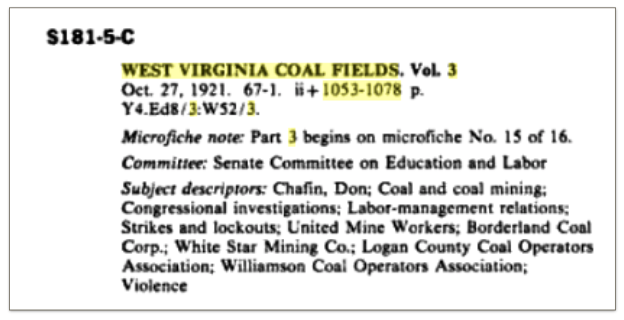 —————
—————
Hellraisers Journal – Tuesday October 18, 1921
Paul Comiskey, Union Bricklayer, Murdered in Logan County Jail
From The Nation of October 5, 1921:
THERE is just one point at issue in the whole sequence of violence and homicide that has led West Virginia into a state of virtual, although unacknowledged, civil war. It is the right to belong to a labor union as represented by the United Mine Workers of America. In the strife-torn territory—the southwestern counties of Mercer, McDowell, Logan, and Mingo—there are no demands for workers’ control, for higher wages or shorter hours. There is not even any immediate question of recognition of the union or collective bargaining.
It is important not to lose sight of this elementary fact in the detail likely to be uncovered in the promised investigation of the West Virginia situation by the Committee on Education and Labor of the United States Senate. Such an inquiry was begun in the summer but adjourned after a few days. Subsequently Senator Kenyon of Iowa and Senator Shortridge of California spent three days—September 18 to 20, inclusive in the coal fields of Mingo and Logan counties and a fourth in talking with State officials in Charleston. On this trip no formal hearings were held nor was any testimony taken under oath. The announced purpose was to get a picture of the country and to lay the base for a searching inquiry later on…..
Now as to suzerainty over county governments exercised by the coal companies and the use of hired gunmen. The two go hand in hand. The entire State of West Virginia has an unenviable reputation for control by the coal operators, but in the actual producing fields local government is at their mercy. Through their mines, their company-owned stores and dwelling houses, their subsidized preachers and teachers, the operators control the livelihood and the lives of virtually the whole population. Hence, politically, the region is their pocket borough. The operators admit and defend the practice of preserving order through deputy sheriffs, paid partially or entirely out of company funds. In addition to these privately-owned public officials, there are also mine guards, armed and exercising police functions without a vestige of authority. Among both these latter classes there are many men whose methods and records justify one in calling them thugs and gunmen. “Private detectives” of the Baldwin-Felts agency are used largely in Mercer, McDowell, and Mingo counties. They are not employed in Logan County. There Sheriff Don Chafin and his company-subsidized deputies rule supreme. When Senators Kenyon and Shortridge went into Logan County they sent word ahead that they especially wanted to see Chafin, but upon arrival he was not on hand and was reported to be away resting after his strenuous efforts in defending the county against invasion by the marching miners a few weeks previous.
His efforts then were indeed strenuous according to two affidavits filed with the Senatorial committee, Floyd D. Griggs, sworn before a notary public at Montgomery, West Virginia, on September 6, declares that he arrived in Logan on August 24 looking for work. Two minutes later he was arrested by a deputy sheriff and taken to the jail. Greggs then states:
On August 29th about 12:30 a. m. I was taken from jail by three armed deputies and taken to the County Court House and into the presence of Don Chafin, sheriff of Logan County, who pinned a white band around my left arm, and was then conducted by the aforesaid Don Chafin into another room of the Court House which was filled with arms and ammunition and told to select a Winchester rifle and go to the front to fight.
I told him that I carried a rifle for eighteen months in the Fifth Regiment, United States Marines, and that I did not intend to go out there and fight against a working man as I was a working man myself. He then drawed a .45 calibre revolver and putting the muzzle in my face told me that I would either fight or die. I told him to shoot as I was not going to fight. He then ordered me sent back to jail.
On Thursday, September 1st, about 7 p. m., I saw a union bricklayer [Paul Comiskey] from Huntington, W. Va., shot down in cold blood murder in the corridor of the jail, not three feet from my cell. Two shots were fired. Two deputies then taken the man that was shot by the feet and dragged him from the jail and across the C. and O. R. R. tracks toward the river.
Greggs concludes by saying that on the night of September 2 he was released by Don Chafin personally, who gave him fifteen minutes to get out of town and until daylight to get out of the county “or get my head blown off.” The affidavit of Greggs is corroborated by one made by Colmar Stanfield, another inmate of the jail at the time, who adds the details that the murdered man was a union bricklayer from Huntington and that he was shot because he refused to fight against the marching miners. Both affidavits name the man who did the shooting, but owing to the gravity of the charge and the absence of an indictment I omit it…..
—————
[Emphasis and paragraph break added.]
From Huntington [Indiana] Herald of September 19, 1921:
[The Affidavit of Colmar Stanfield states:]
I witnessed two deputy sheriffs bring prisoners over to the jail. They were beating and kicking one man, a union bricklayer from Huntington, West Virginia. He was kept in jail all day.
On refusing to fight he was taken from his cell into the corridor and shot down in cold blood. Two deputies then took him by the feet and dragged him from the jail.
[Emphasis added.]
From the Winston-Salem Twin City Sentinel of September 2, 1921:
[Death of Paul Comiskey in Logan County Jail.]
Logan, W. Va., Sept. 2.-Early morning reports from Spruce Forks Ridge told little of conditions of the Logan county border, where firing was spasmodic by each side last night. Col. E. E. Eubanks of the national guard, in command of Logan county force, had no official statement to make, he said, and Sheriff Don chafin was equally reticent.
Three prisoners taken by patrols and brought here last night were locked in the county jail where an hour before a fatal shooting had occurred.
While being transferred from on cell to another Paul Comiskey, arrested at Ethel yesterday, charged with being a suspicious person, attacked Jailor W. E. White, whereupon, the officer stated, he shot and killed him.
Comiskey brought here for confinement after his arrest at Ethel, carried papers indication that at one time he was an employe of the Winding Gulf Coal company. Baggage checks in his pockets showed that he had checked trunks at Charleston.
—————
~~~~~~~~~~~~~~~~~~~~
SOURCES & IMAGES
The Nation Volume 113
(New York, New York)
July-Dec 1921
https://books.google.com/books?id=4Pw4AQAAMAAJ
The Nation of Oct 5, 1921, pages 372-3
“Industrialism Gone Mad” by Arthur Warner
https://play.google.com/books/reader?id=4Pw4AQAAMAAJ&pg=GBS.PA372
Sept 19, 1921, Huntington Herald [IN], page 1
-re affidavits by Floyd D. Griggs [or Greggs?] and Colmar Stanfield, witnesses to murder of Paul Comiskey in Logan County Jail: “put in the hands of Senator Kenyon chairman of the committee by Harold F. Houston, attorney for the United Mine Workers of America.”
https://www.newspapers.com/clip/87424018/sept-19-1921-huntington-in-herald-re/
Twin City Sentinel
(Winston-Salem, North Carolina)
-Sept 2, 1921
Note name: “Paul Comiskey”
https://www.newspapers.com/image/91969826/
See also:
Thunder In the Mountains
The West Virginia Mine War, 1920–21
-Lon Savage
University of Pittsburgh Pre, Sep 11, 1990
(search: comiskey)
https://books.google.com/books?id=u-n7AwAAQBAJ
page 140:
In the midst of the mine war, at the height of the miners’ attack, a Wobbly somehow managed to arrive in Logan Town.
We have only his last name: Comiskey, a bricklayer, who got off the train from Huntington with an IWW card in his pocket…
He was arrested within minutes. Sheriff Chafin said he was drunk and disorderly and had “criticized” unnamed Logan citizens. A local press report said only that the man “gave utterances of his position and was immediately placed in jail.”
Next night, about seven o’clock, Oscar White, the jailer’s eighteen-year-old son, entered the jail cell area. He carried a revolver for which he had no permit. His father had told the boy to exercise the prisoners.
The boy unlocked a large jail cell and let Comiskey and a dozen other prisoners out into corridor. There, the boy said, Comiskey swung at him, knocking him to the floor. From the floor, his head against the wall, young White fired his revolver, and Comiskey fell, shot through the groin. He died several hours later. That was the way Chafin told it.
Note: Sadly, Savage describes the IWW as a “federation of labor organizations,” rather than as The One Big Union. Not able, at this time, to verify that Comiskey was an IWW member or that he had a Red Card in his pocket.
Savage gives these sources:
Warner’s article, see above.
Logan Banner of Sept 2, 1921, p1 (not found online.)
WVCF (Sen Com Investigation 1921) pages 1056-7, 1062, 1070-1, 1078,
-re Sen Com WV Investigation 1921 X3 Volumes
Pages after 1054 of WVCF are from Vol. 3, not yet found online.
https://books.google.com/books?id=QHAW4S-kUCQC&pg=PA525
~~~~~~~~~~~~~~~~~~~~~~~~~~~~~~~~~~~~~~~~
The Red Flag – Socialist Victory Choir


